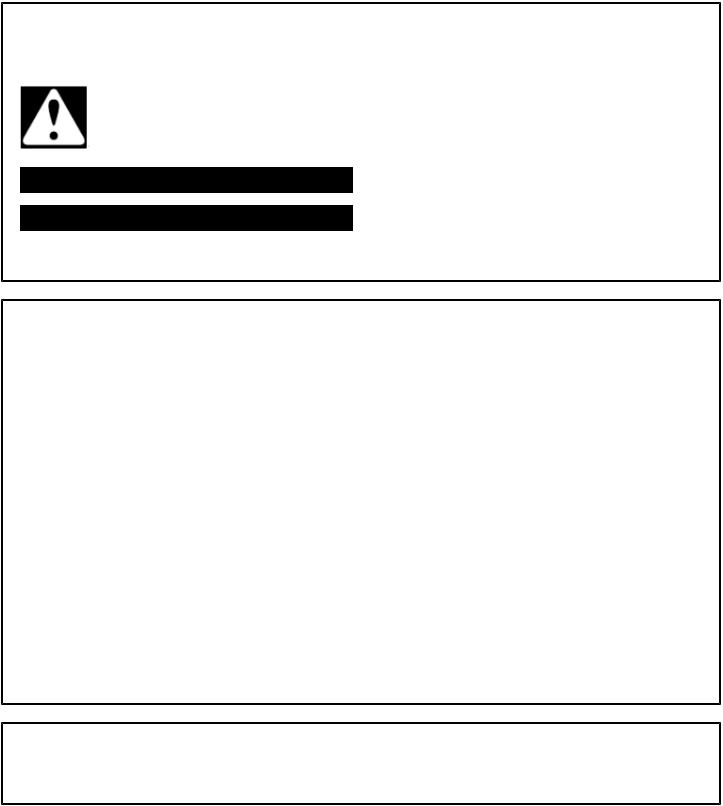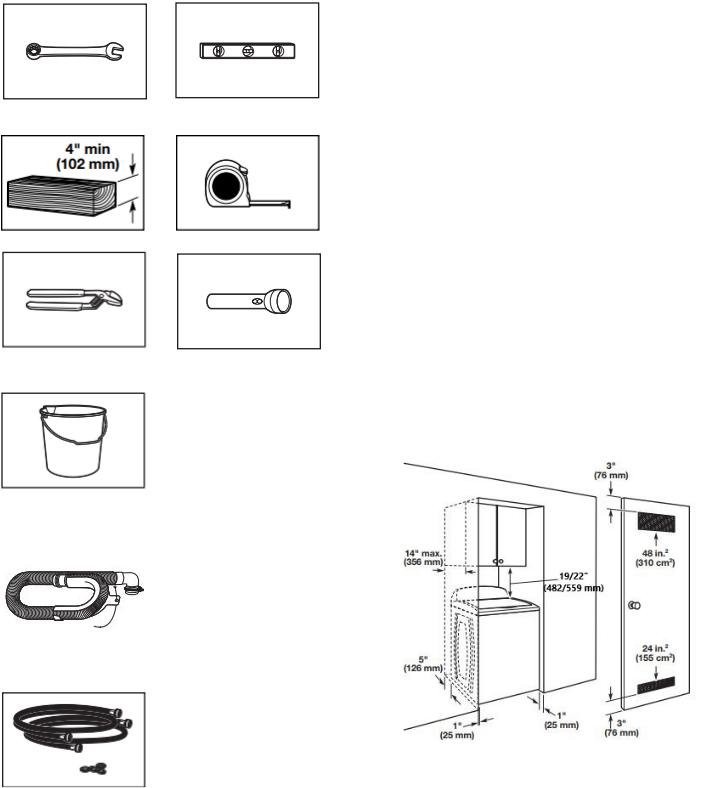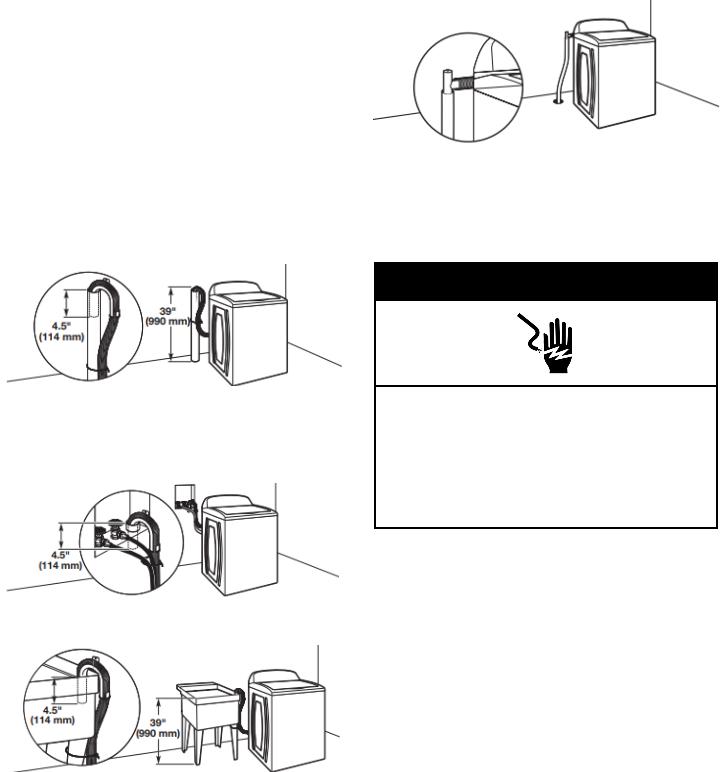Maytag MVWB765FC3 Owner’s Manual

TOP LOAD WASHER OWNER’S MANUAL MANUEL DE L’UTILISATEUR DE LA LAVEUSE À CHARGEMENT PAR LE DESSUS
Table of Contents |
|
WasherSafety......................................................... |
2 |
Washer Maintenance and Care ............................... |
3 |
Water Inlet Hoses............................................... |
3 |
Washer Care...................................................... |
3 |
Nonuse and Vacation Care ................................. |
4 |
Winter Storage Care........................................... |
4 |
Transporting Your Washer................................... |
4 |
Reinstalling/Using Washer Again......................... |
4 |
Installation Instructions. ..........................................5 |
|
Requirements.......................................................... |
5 |
Tools and Parts .................................................. |
5 |
Location Requirements....................................... |
5 |
Drain System ..................................................... |
6 |
Electrical Requirements ...................................... |
6 |
Installation............................................................... |
7 |
Unpacking ......................................................... |
7 |
Connect Drain Hose ........................................... |
8 |
Connect Inlet Hoses ........................................... |
8 |
Level Washer..................................................... |
9 |
Complete Installation Checklist.......................... |
10 |
Table des matières |
|
Sécuritéde la laveuse............................................ |
11 |
Entretienet réparation de la laveuse ..................... |
12 |
Tuyaux d’arrivée d’eau...................................... |
12 |
Entretien de la laveuse ..................................... |
12 |
Non utilisation et entretien avant les |
|
vacances ......................................................... |
13 |
Entretien pour entreposage hivernal .................. |
13 |
Transport de la laveuse..................................... |
13 |
Réinstallation/réutilisation de la laveuse ............. |
13 |
Instructions d'installation......................................... |
14 |
Spécifications........................................................ |
14 |
Outillage et pièces............................................ |
14 |
Exigences d’emplacement ................................ |
14 |
Système de vidange ......................................... |
15 |
Spécifications électriques ................................. |
16 |
Installation............................................................. |
16 |
Déballage ........................................................ |
16 |
Raccordement du tuyau de vidange................... |
17 |
Raccordement des tuyaux d’alimentation ........... |
18 |
Établissement de l'aplomb de la laveuse ............ |
19 |
Liste de vérification pour l’achèvement de |
|
l’installation...................................................... |
20 |
W11354658A W11354659-SP

WASHER SAFETY
Your safety and the safety of others are very important.
We have provided many important safety messages in this manual and on your appliance. Always read and obey all safety messages.
This is the safety alert symbol.
This symbol alerts you to potential hazards that can kill or hurt you and others.
All safety messages will follow the safety alert symbol and either the word “DANGER” or “WARNING.” These words mean:
 DANGER
DANGER
 WARNING
WARNING
You can be killed or seriously injured if you don't immediately follow instructions.
You can be killed or seriously injured if you don’t follow instructions.
All safety messages will tell you what the potential hazard is, tell you how to reduce the chance of injury, and tell you what can happen if the instructions are not followed.
IMPORTANT SAFETY INSTRUCTIONS
WARNING: To reduce the risk of fire, electric shock, or injury to persons when using your appliance, follow basic precautions, including the following:
Read all instructions before using the appliance.
Do not wash articles that have been previously cleaned in, washed in, soaked in, or spotted with gasoline, dry-cleaning solvents, or other flammable or explosive substances, as they give off vapors that could ignite or explode.
Do not add gasoline, dry-cleaning solvents, or other flammable or explosive substances to the wash water. These substances give off vapors that could ignite or explode.
Under certain conditions, hydrogen gas may be produced in a hot-water system that has not been used for 2 weeks or more. HYDROGEN GAS IS EXPLOSIVE. If the hot-water system has not been used for such a period, before using a washing machine, turn on all hot-water faucets and let the water flow from each for several minutes. This will release any accumulated hydrogen gas. As the gas is flammable, do not smoke or use an open flame during this time.
Do not allow children to play on or in the appliance. Close supervision of children is necessary when the appliance is used near children.
Before the appliance is removed from service or discarded, remove the door.
Do not reach into the appliance if the tub or agitator is moving.
Do not install or store this appliance where it will be exposed to the weather.
Do not tamper with controls.
Do not repair or replace any part of the appliance or attempt any servicing unless specifically recommended in the usermaintenance instructions or in published user-repair instructions that you understand and have the skills to carry out.
Do not use replacement parts that have not been recommended by the manufacturer (e.g. parts made at home using a 3D printer).
See the Installation Instructions for grounding requirements and installation.
SAVE THESE INSTRUCTIONS
WARNING
Certain internal parts are intentionally not grounded and may present a risk of electric shock only during servicing. Service Personnel – Do not contact the thermostat bracket while the appliance is energized.
2
CHOOSING THE RIGHT
DETERGENT
Use only High Efficiency detergents. The package will be marked “HE” or “High Efficiency.” Low-water washing creates excessive sudsing with a non-HE detergent. Using non-HE detergent will likely result in longer cycle times and reduced rinsing performance. It may also result in component malfunction and, over time, buildup of mold or mildew. HE detergents should be low-sudsing and quick-dispersing to produce the right amount of suds for the best performance. They should hold soil in suspension so it is not redeposited onto clean clothes. Not all detergents labeled as High Efficiency are identical in formulation and their ability to reduce suds. For example, natural, organic, or homemade HE detergents may generate a high level of suds. Always follow the detergent manufacturer’s instructions to determine the amount of detergent to use. Do not go over the Max Line on the dispenser. See Quick Start Guide for more information.
WASHER MAINTENANCE AND CARE
Water Inlet Hoses
Replace inlet hoses after 5 years of use to reduce the risk of hose failure. Periodically inspect and replace inlet hoses if bulges, kinks, cuts, wear, or leaks are found.
When replacing your inlet hoses:
Mark the date of replacement on the label with a permanent marker.
Check that the old washers are not stuck on the washer inlet valves.
Use new washers in the new inlet hoses to ensure a proper seal.
NOTE: This washer may not include inlet hoses. See the Installation Instructions for more information.
Washer Care
Recommendations to help keep your washer clean and performing at its best
1.Always use High Efficiency (HE) detergents and follow the HE detergent manufacturer’s instructions regarding the amount of HE detergent to use. Never use more than the recommended amount because that may increase the rate at which detergent and soil residue accumulate inside your washer, which in turn may result in undesirable odor.
2.Use warm and hot wash water settings sometimes (not exclusively cold water washes), because they do a better job of controlling the rate at which soils and detergent accumulate.
3.Always leave the washer lid open between uses to help dry out the washer and prevent the buildup of odor-causing residue.
Cleaning your top-loading washer
Read these instructions completely before beginning the routine cleaning processes recommended below. This Washer Maintenance Procedure should be performed, at a minimum, once per month or every 30 wash cycles, whichever occurs sooner, to control the rate at which soils and detergent may otherwise accumulate in your washer.
Cleaning the inside of the washer
To keep your washer odor-free, follow the usage instructions provided above and use this recommended monthly cleaning procedure:
Recommended cycle for cleaning the asher
Some models have a “Clean Washer” cycle that uses higher water volumes in combination with affresh® Washer Cleaner or liquid chlorine bleach to clean the inside of the washer.
If your model does not have a “Clean Washer” cycle, refer to the online Cycle Guide for the optimal cycle for cleaning the inside of the washer. Use this cycle with affresh® Washer Cleaner or liquid chlorine bleach as described below.
Description of Clean Washer with affresh® cycle operation:
1.This cycle will fill to a washer level high than in normal wash cycles to provide rinsing than in normal wash cycles to provide rinsing at a level above the water line for normal wash.
2.During this cycle, there will be some agitation and spinning to increase the removal of soils.
After this cycle is complete, leave the lid open to allow for better ventilation and drying of the washer interior.
Begin procedure
1.Affresh® washer cleaner cycle procedure (recommended for best performance):
a.Open the washer lid and remove any clothing or items.
b.Place an affresh® Washer Cleaner tablet in the bottom of the washer basket.
c.Do not place an affresh® Washer Cleaner tablet in the detergent dispenser.
d.Do not add any detergent or other chemical to the washer when following this procedure.
e.Close the washer lid.
f.Select the cycle recommended for cleaning the inside of the washer.
g.Press the Start button to start the cycle.
NOTE: For best results, do not interrupt cycle. If cycle must be interrupted, press Power/Cancel. (For models with no Power/ Cancel button, press and hold Start/Pause for three seconds.) After the cycle has stopped, run a Rinse & Spin cycle to rinse cleaner from washer.
2.Chlorine bleach procedure (alternative):
a.Open the washer lid and remove any clothing or items.
b.Add 1 cup (236 mL) of liquid chlorine bleach to the bleach compartment.
NOTE: Use of more liquid chlorine bleach than is recommended above could cause washer damage over time.
c.Close the washer lid.
d.Do not add any detergent or other chemical to the washer when following this procedure.
e.Select the cycle recommended for cleaning the inside of the washer.
f.Press the Start button to start the cycle.
NOTE: For best results, do not interrupt cycle. If cycle must be interrupted, press Power/Cancel. (For models with no Power/ Cancel button, press and hold Start/Pause for three seconds.) After the cycle has stopped, run a Rinse & Spin cycle to rinse cleaner from washer.
Cleaning the dispensers
After a period of using your washer, you may find some residue buildup in the washer’s dispensers.
IMPORTANT: Dispensers are not dishwasher-safe.
3

For non-removable dispensers:
To remove residue from the dispensers, wipe them with an affresh® Machine Cleaning Wipe or a damp cloth and towel dry. Do not attempt to remove the dispensers or trim for cleaning. The dispensers and trim are not removable.
For removable dispensers:
If your model has a dispenser drawer, press tab(s) to remove the drawer and clean it with an affresh® Machine Cleaning Wipe or a damp cloth and towel dry before or after you run the Clean Washer cycle. Use an all-purpose surface cleaner, if needed.
Cleaning the outside of the washer
IMPORTANT: To avoid damaging the washer’s finish, do not use abrasive products.
Use an affresh® Machine Cleaning Wipe, a soft, damp cloth, or sponge to wipe away any spills. Use an affresh® Machine Cleaning Wipe or only mild soaps or cleaners when cleaning external washer surfaces.
Nonuse and Vacation Care
Operate your washer only when you are home. If moving, or not using your washer for a period of time, follow these steps:
1.Unplug or disconnect power to washer.
2.Turn off water supply to washer to avoid flooding due to water pressure surge.
Winter Storage Care
IMPORTANT: To avoid damage, install and store washer where it will not freeze. Because some water may stay in hoses, freezing can damage washer. If storing or moving during freezing weather, winterize your washer.
To winterize washer:
1.Shut off both water faucets; disconnect and drain water inlet hoses.
2.Put 1 L (1 qt.) of R.V.-type antifreeze in basket and run washer on Rinse & Spin cycle for about 30 seconds to mix antifreeze and remaining water.
3.Unplug washer or disconnect power.
Transporting Your Washer
1.Shut off both water faucets. Disconnect and drain water inlet hoses.
2.If washer will be moved during freezing weather, follow “Winter Storage Care” directions before moving.
3.Disconnect drain hose from drain system and drain any remaining water into a pan or bucket. Disconnect drain hose from back of washer.
4.Unplug power cord.
5.Place inlet hoses and drain hose inside washer basket.
6.Drape power cord over edge and into washer basket.
7.Place original shipping materials back inside washer. If you do not have shipping materials, place heavy blankets or towels into basket opening. Close lid and place tape over lid and down front of washer. Keep lid taped until washer is placed in new location. Transport washer in the upright position.
Reinstalling/Using Washer Again
 WARNING
WARNING
Electrical Shock Hazard
Plug into a grounded 3 prong outlet.
Do not remove ground prong.
Do not use an adapter.
Do not use an extension cord.
Failure to follow these instructions can result in death, fire, or electrical shock.
To reinstall washer after nonuse, vacation, winter storage, or moving:
1.Refer to Installation Instructions to locate, level, and connect washer.
2.Before using again, run washer through the following recommended procedure:
To use washer again:
1.Flush water pipes and hoses.
2.Reconnect water inlet hoses.
3.Turn on both water faucets.
4.Plug into a grounded 3 prong outlet or reconnect power.
5.See your online Cycle Guide for information about which cycle(s) to run your washer through to clean washer and remove antifreeze, if used. Use only HE High Efficiency detergent. Use half the manufacturer’s recommended amount for a medium-size load.
4

INSTALLATION INSTRUCTIONS REQUIREMENTS
Tools and Parts
Gather required tools and parts before starting installation.
Tools Needed:
Adjustable or open end |
Level |
wrench 9/16″ (14 mm) |
|
Wood block |
Ruler or measuring tape |
Adjustable pliers that |
Flashlight |
open to 1 3/4″ (45 mm) |
|
Bucket
Parts Supplied:
NOTE: All parts supplied for installations are in the washer.
Drain hose with clamp, U-form, and cable tie
Parts Needed: (if not supplied with washer)
|
NOTE: Various inlet hose |
|
options are available; check |
|
your Quick Start Guide for |
Inlet hoses with flat washers |
ordering information. |
Alternate Parts: (not supplied with washer)
Your installation may require additional parts. To order, please refer to the contact information referenced in your Quick Start Guide.
If you have: |
You will need: |
Overhead sewer |
Standard 20 gal. (76 L) 39″ (990 mm) |
|
tall drain tub or utility sink, sump pump, |
|
and connectors (available from local |
|
plumbing suppliers) |
1″ (25 mm) standpipe |
2″ (51 mm) diameter to 1″ (25mm) |
|
diameter standpipe adapter and |
|
connector kit |
Drain hose too short |
Extension drain hose and connector kit |
Lint-clogged drain |
Drain protector and connector kit |
Location Requirements
Select proper location for your washer to improve performance and minimize noise and possible “washer walk.” Install your washer in a basement, laundry room, closet, or recessed area.
IMPORTANT: Do not install, store, or operate washer where it will be exposed to weather or in temperatures below 32°F (0°C). Water remaining in washer after use may cause damage in low temperatures. See “Washer Maintenance and Care” for winterizing information.
Proper installation is your responsibility.
You will need:
A water heater set to 120°F (49°C).
A grounded electrical outlet located within 4 ft. (1.2 m) of power cord on back of washer.
Hot and cold water faucets located within 3 ft. (0.9 m) of hot and cold water fill valves on washer, and water pressure of 20– 100 psi (138–690 kPa).
A level floor with maximum slope of 1″ (25 mm) under entire washer. Installing on carpet or surfaces with foam backing is not recommended.
Floor must support washer’s total weight (with water and load) of 315 lbs. (143 kgs).
Recessed area or closet installation
NOTE: All 27″ wide washers should have 19″ clearance, while all 29″ wide washers should have 22″ clearance.
5

All dimensions show recommended spacing allowed, except for closet door ventilation openings, which are the minimum required. This washer has been tested for installation with spacing of 0″
(0 mm) clearance on the sides. Consider allowing more space for ease of installation and servicing, and spacing for companion appliances and clearances for walls, doors, and floor moldings. Add spacing of 1″ (25 mm) on all sides of washer to reduce noise transfer. If a closet door or louvered door is installed, top and bottom air openings in door are required.
*For additional details (or information) specific to your model, refer to your Quick Start Guide.
Drain System
Drain system can be installed using a floor drain, wall standpipe, floor standpipe, or laundry tub. Select the method you need.
IMPORTANT: To avoid siphoning, no more than 4.5″ (114 mm) of drain hose should be inside standpipe or below the top of wash tub. Secure drain hose with cable tie.
Floor standpipe drain system
Minimum diameter for a standpipe drain: 2″ (51 mm). Minimum carry-away capacity: 17 gal. (64 L) per minute. Top of standpipe must be at least 39″ (990 mm) high; install no higher than 96″ (2.44 m) from bottom of washer. If you must install higher than 96″ (2.44 m), you will need a sump pump system.
Wall standpipe drain system
See requirements in the “Floor standpipe drain system” section.
Laundry tub drain System
Minimum capacity: 20 gal. (76 L). Top of laundry tub must be at least 39″ (990 mm) above floor; install no higher than 96″ (2.44 m) from bottom of washer.
Floor Drain System
Floor drain system requires a Siphon Break Kit, 2 Connector Kits, and an Extension Drain Hose that may be purchased separately; refer to the Quick Start Guide for online ordering information.
Minimum siphon break height: 28″ (710 mm) from bottom of washer (additional hoses may be needed).
Electrical Requirements
 WARNING
WARNING
Electrical Shock Hazard
Plug into a grounded 3 prong outlet.
Do not remove ground prong.
Do not use an adapter.
Do not use an extension cord.
Failure to follow these instructions can result in death, fire, or electrical shock.
A 120 V, 60 Hz, AC-only, 15 or 20 A, fused electrical supply is required. A time-delay fuse or circuit breaker is recommended. It is recommended that a separate circuit breaker serving only this appliance be provided.
This washer is equipped with a power supply cord having a 3-prong grounding plug.
To minimize possible shock hazard, the cord must be plugged into a mating, 3-prong, grounding-type outlet, grounded in accordance with local codes and ordinances. If a mating outlet is not available, it is the personal responsibility and obligation of the customer to have the properly grounded outlet installed by a qualified electrician.
If codes permit and a separate ground wire is used, it is recommended that a qualified electrician determine that the ground path is adequate.
Do not ground to a gas pipe.
Check with a qualified electrician if you are not sure the washer is properly grounded.
Do not have a fuse in the neutral or ground circuit.
6
